The sun serves as the center and life-giver of our solar system. Classified as a yellow dwarf, this star comprises 99.86% of the total mass of our system and exerts the strongest gravitational force over all celestial bodies. Since ancient times, humanity has recognized the vital role of the Sun in sustaining life on Earth, as evidenced by its mention in early texts and depictions in rock art. It was revered as the supreme deity, reigning over all creation.
Engaging trivia
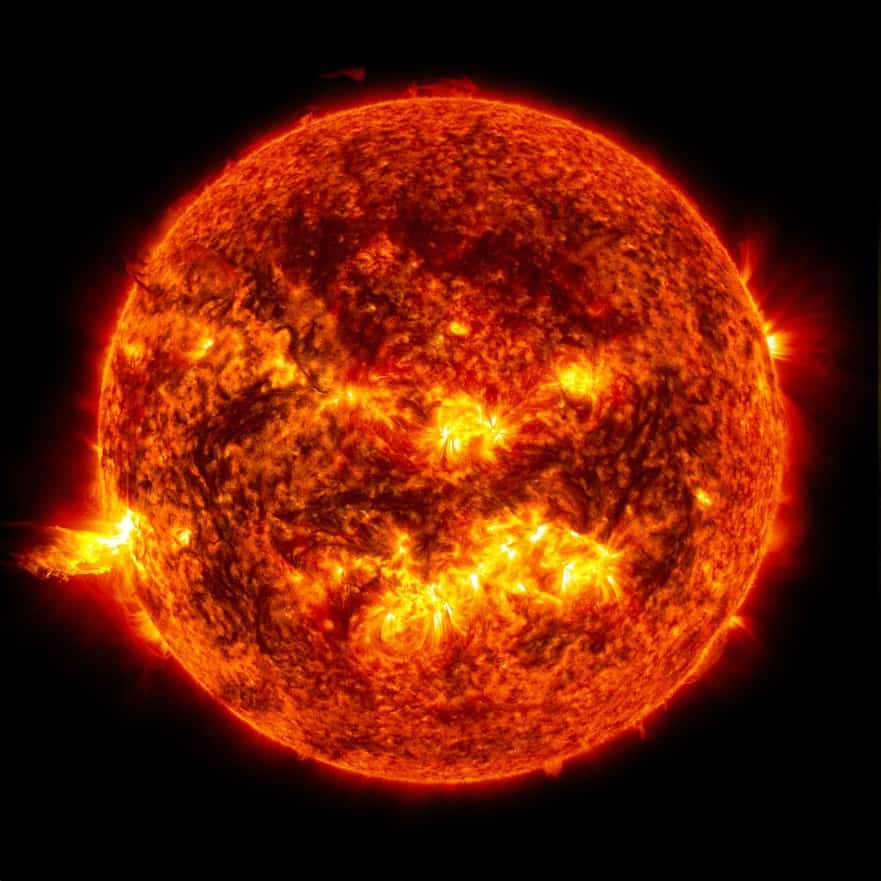
Discover the most fascinating information about the Sun, the solitary star within the solar system.
- If we were to fill our Sun, it would accommodate 960,000 Earths. However, if we compress them and eliminate free space, the number rises to 1,300,000. The Sun’s surface area is 11,990 times that of the Earth.
- The difference between the Sun’s equatorial and polar diameters is merely 10 kilometers. This indicates that we have one of the celestial bodies closest to being perfectly spherical.
- The Sun’s core reaches such high temperatures through the process of fusion, where hydrogen is converted into helium. Despite the natural tendency for hot objects to expand, the Sun is able to maintain its size due to the powerful force of gravity. The surface temperature of the Sun is relatively cooler at 5,780 °C.
- Once the Sun exhausts its hydrogen supply, which is estimated to occur in approximately 130 million years, it will transition to using helium as fuel. This change will cause the Sun to expand in size and engulf the first three planets in its path. This phase is known as the red giant stage.
- Following the red giant stage, the Sun will undergo a collapse and transform into a compact mass roughly the size of Earth. This final phase is referred to as the white dwarf stage.
- The Earth is situated at a distance of 150 million kilometers from the Sun. With the speed of light being 300,000 kilometers per second, it takes approximately 8 minutes and 20 seconds for a beam of light to travel this distance. It is worth noting, however, that the photons of light that reach the surface of the Earth have actually been traveling for millions of years, originating from the core of the Sun.
- The Sun is located approximately 24,000-26,000 light years away from the galactic center. As a result, it takes around 225-250 million years for the Sun to complete one orbit around the center.
- Due to the Earth’s elliptical orbital path, its distance from the Sun varies between 147-152 million kilometers (known as an astronomical unit).
- The Sun is estimated to be 4.5 billion years old, indicating that it has already consumed around half of its hydrogen supply. However, this process will continue for another 5 billion years.
- The solar wind is a flow of charged particles that traverse through the solar system at a velocity of 450 kilometers per second. This wind becomes visible where the Sun’s magnetic field extends.
- The term “solar” itself has its origins in Ancient Anglo-Anglian, which means “south”. It also has Gothic and Germanic roots. Prior to 700 AD, Sunday was referred to as “sunny day”. Translation has also played a role in its development. The original Greek term “heméra helíou” transformed into the Latin term “dies solis”.
Characterization
Comparison of the sizes of the Sun and the planets in our solar system. The distances between the objects are being observed.
The Sun is a G-type main-sequence star with an absolute magnitude of 4.83, making it brighter than approximately 85% of the other stars in our galaxy, many of which are red dwarfs. It has a diameter of 696,342 km and a mass of – 1.988 x 10^30 kg. This means that the Sun is 109 times larger than Earth and 333,000 times more massive.
Being a star, the Sun’s density varies from layer to layer. On average, it is 1.408 g/cm^3. However, closer to the core, the density increases to 162.2 g/cm^3, which is 12.4 times that of Earth’s density.
While it may appear yellow in the sky, the true color of the Sun is actually white. The atmosphere is responsible for creating the visibility of the Sun. As you move closer to the center of the Sun, the temperature increases. The core is heated to a scorching 15.7 million K, the corona reaches a temperature of 5 million K, and the visible surface of the Sun is heated to 5778 K.
Physical characteristics of the Sun
The Sun is composed of plasma, which gives it a strong magnetic field. It has both north and south magnetic poles, and these magnetic field lines create the activity observed on the surface of the Sun. Cool spots, known as dark spots, are indicators of cycling.
Coronal mass ejections and flares occur when the magnetic field lines of the Sun readjust. This cycle takes approximately 11 years, during which the activity of the Sun increases and then subsides. The maximum activity of the Sun is accompanied by the highest number of sunspots.
The brightness of the star is incredibly high, with an apparent magnitude of -26.74, which is 13 billion times brighter than Sirius, whose magnitude is -1.46. The distance between the Earth and the Sun is 150 million kilometers, also known as 1 astronomical unit (a.u.). It takes a light ray approximately 8 minutes and 19 seconds to travel this distance.
Composition and structure
The star is predominantly composed of hydrogen (74.9%) and helium (23.8%). The other elements present in smaller quantities are oxygen (1%), carbon (0.3%), neon (0.2%), and iron (0.2%). The star’s interior consists of several layers, including the core, radiation and convective zones, photosphere, and atmosphere. The core, which occupies about 20-25% of the total volume, has the highest density, measuring approximately 150 g/cm3.
The plasma ball, which is the star, undergoes a rotation that takes approximately one month to complete. However, this estimation may not be entirely accurate due to the nature of the plasma. Scientific analysis reveals that the core of the star spins at a faster rate compared to its outer layers. Specifically, the equatorial line completes one revolution in 25.4 days, while it takes 36 days for the poles to complete a revolution.
Deep within the star’s core, the process of nuclear fusion converts hydrogen into helium, generating solar energy. It is within this core that almost 99% of the thermal energy is produced.
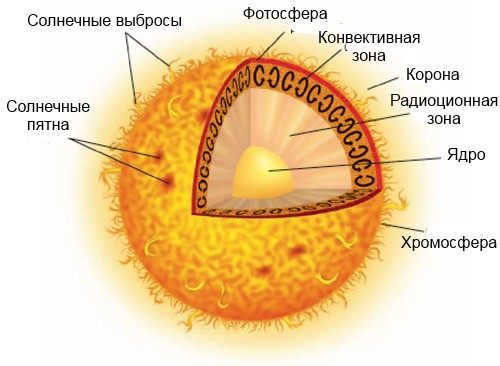

The Sun’s inner structure. The radiation zone spans from 0.25 to 0.7 of the solar radius. The temperature decreases as one moves away from the core. In this area, it drops from 7 million K to 2 million K. The density follows the same trend – from 20 g/cm3 to 0.2 g/cm3.
There exists a transitional layer called the tacholine between the radiative zone and the convective zone. This layer exhibits a noticeable abrupt change in the uniform rotation of the radiative zone and the differential rotation of the convective zone, leading to a significant displacement. The convective zone is located 200,000 km beneath the surface, where the temperature and density are also decreased.
The photosphere is the visible surface of the sun. Light can freely propagate into space from this surface, releasing solar energy. It has a thickness of hundreds of kilometers.
The upper part of the photosphere experiences less heating compared to the lower part. The temperature rises to 5700 K, while the density measures 0.2 g/cm3.

The exploration of the solar heliosphere has been greatly enhanced by the Voyager 1 and 2 spacecraft.
Stretching beyond the heliopause, which is located 50 astronomical units from the star, the heliosphere is a magnetic sphere that is also known as the solar wind.
Development and Prospects
Scientists have a strong belief that the Sun came into existence approximately 4.57 billion years ago as a result of the collapse of a segment of the molecular cloud comprised of hydrogen and helium. Concurrently, the Sun began to rotate due to angular momentum and its temperature began to rise as the pressure increased.
The majority of the mass gathered at the center, while the remaining matter formed the disk that would later give rise to the planets we are familiar with. The combination of gravity and pressure caused a rise in temperature, leading to the occurrence of nuclear fusion. An explosion took place, giving birth to the Sun. The various stages of stellar evolution can be traced in the diagram.
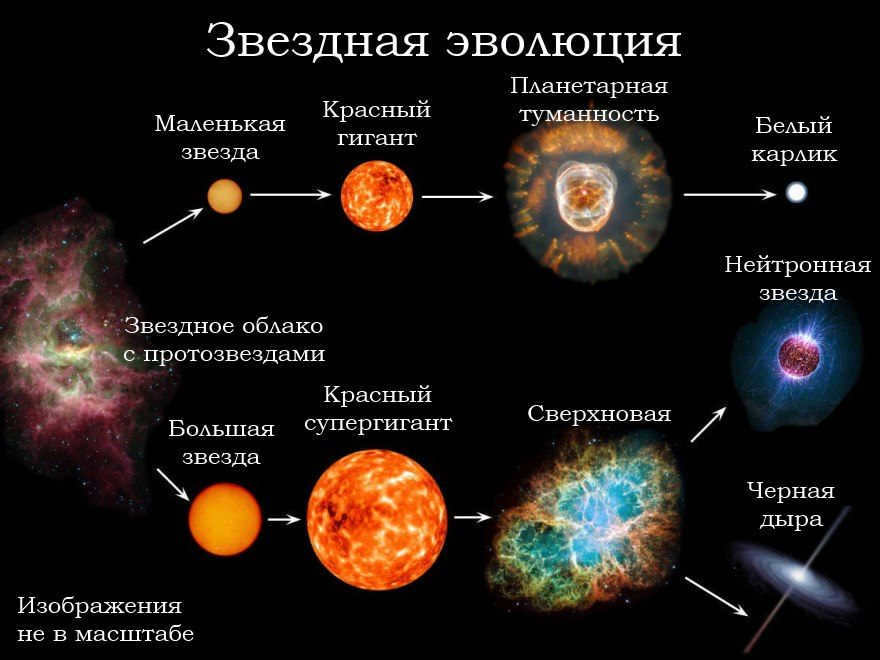
At present, the Sun is in the phase known as the main sequence. Within its core, more than 4 million tons of matter are being converted into energy. The temperature is gradually rising. Research indicates that over the course of the past 4.5 billion years, the Sun has experienced a 30% increase in brightness, with a growth rate of 1% every 100 million years.
It is hypothesized that in the future, the Sun will expand and evolve into a red giant. As a result of this expansion, Mercury, Venus, and potentially Earth will perish. The red giant phase is projected to endure for approximately 120 million years.
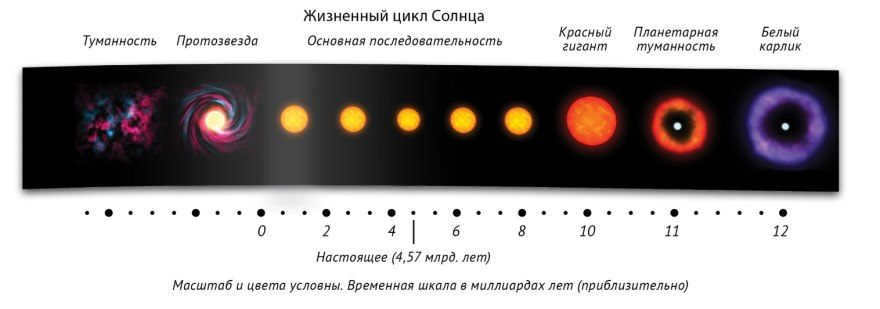
Subsequently, the Sun will initiate a process of contraction in both size and temperature. It will proceed to consume the remaining helium in its core until it is completely depleted. Following a span of 20 million years, it will undergo destabilization. Either the Earth will be annihilated or it will experience scorching temperatures. In approximately 500,000 years, only half of the Sun’s mass will remain, and the outer layer will generate a nebula. Ultimately, we will be left with a white dwarf that will endure for countless trillions of years before ultimately transforming into a black dwarf.
Position within the Milky Way
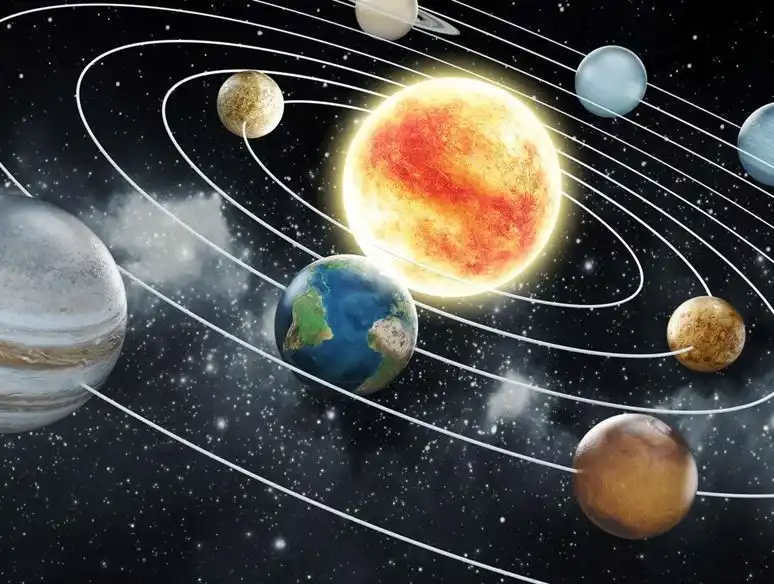
The position of the Sun within the Milky Way galaxy
The Sun is situated in the inner region of the Orion arm of the Milky Way galaxy. It is approximately 7.5-8.5 thousand parsecs away from the center of the galaxy. Within the interstellar medium, it is located within a local bubble, which is a void filled with luminous gas.
Within the galactic habitable zone, the solar system is found. This specific region possesses unique characteristics that are conducive to supporting life. The Sun’s movement is directed towards Vega in the constellation Lyra, and it is angled approximately 60 degrees away from the galactic center. Among the nearest 50 star systems, the Sun ranks as the 40th most massive.
Map of the surface
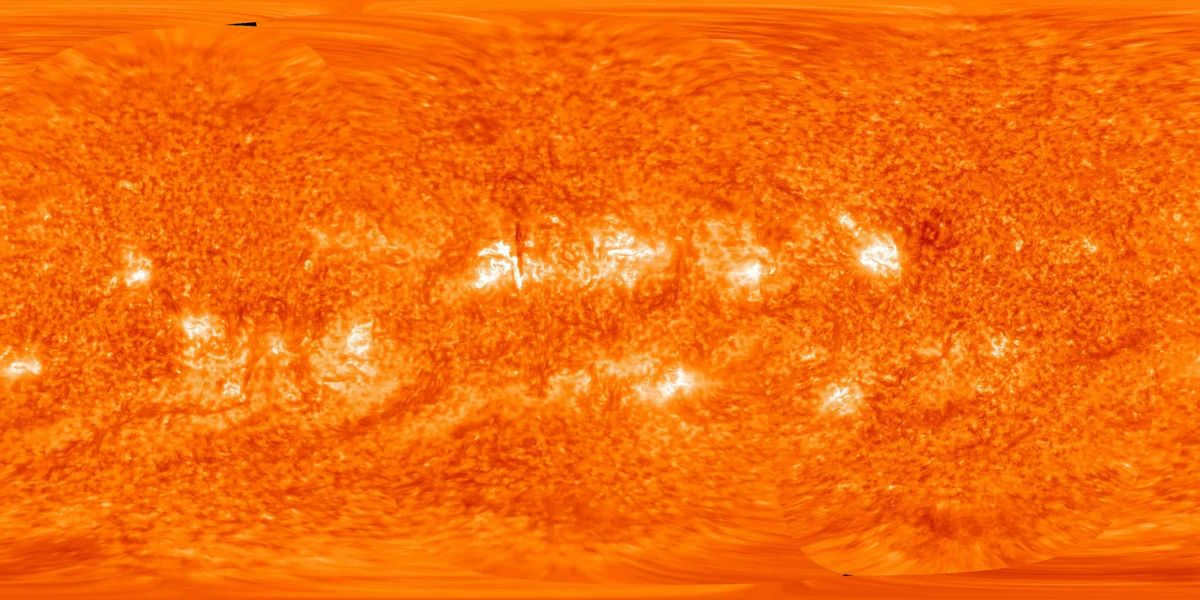

Feel free to click on the image in order to view it in a larger size
The Sun’s position and movement
- The solar cycle;
- The magnetic field of the Sun;
- Sunspots;
- Torches;
- Protuberances;
- Flocculi and fibers;
- Spicules;
- Coronal holes;
- Coronal loops;
- Coronal streamers;
- Pellets and super pellets;
- Solar radiation;
- Solar wind;
Based on conventional estimates, the Sun came into existence around 4.59 billion years ago. While some astronomers have recently speculated that its age may be closer to 6-7 billion years, these ideas remain speculative. It is important to note that the birth of our Sun was not a result of random chance. Instead, it originated from a colossal cloud of gas and dust, primarily composed of molecular hydrogen. Over time, the force of its own gravity caused this cloud to gradually compress and reshape into a flat disk. It is conceivable that the cloud’s collapse was triggered by a cosmic event, such as an encounter with a massive star or a supernova explosion. Within the center of this disk, a sphere of luminous plasma formed, with a surface temperature reaching several thousand degrees. As a result, it released a portion of its gravitational energy in the form of heat.
The infant celestial body proceeded to diminish in size, causing its inner core to become increasingly hotter. After a couple of million years, its temperature soared to 10 million degrees Celsius, initiating self-sustaining fusion reactions. The juvenile protostar transformed into a typical main-sequence star. The material found in the immediate and distant outskirts of the disk condensed into frigid entities – planets and planetoids.
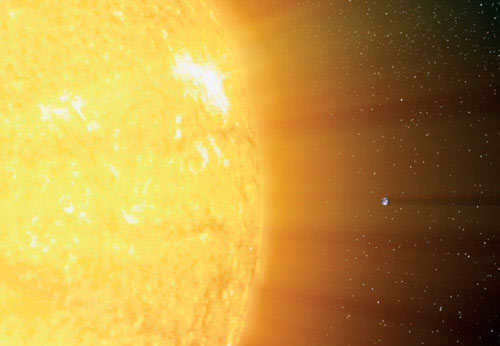
Here are some data sheets for the Sun. The Sun is estimated to be around 4.59 billion years old and has a mass of approximately 1.989×10^30 kg. Its average radius is about 696,000 km, and its average density is 1.409 g/cm^3, which is four times lower than the density of Earth’s matter. The Sun’s effective surface temperature, calculated assuming it radiates as a completely black body, is about 5503°C (or 5778 Kelvin in terms of absolute temperature). The total radiation power of the Sun is approximately 3.83×10^23 kW.
Unlike planets, the Sun does not rotate as a single unit, so it doesn’t have defined days. The surface of its equatorial zone takes about 27 Earth days to complete a full revolution, while the circumpolar zones take around 35 days. The axial rotation of the solar interior is even more complex and not fully understood.
Solar mechanics
The Sun’s layered structure is often likened to that of an onion, although this analogy doesn’t quite capture the powerful vertical flows of matter and energy that permeate the layers. Nevertheless, it serves as a useful approximation. The Sun shines thanks to the thermonuclear energy generated in its core, where temperatures reach a scorching 15 million degrees Celsius, density is 160 g/cm3, and pressure reaches an astounding 3.4×1011 atm. In these extreme conditions, a series of thermonuclear reactions known as the proton-proton cycle (p-p-cycle) take place. This cycle gets its name from the initial reaction in which two protons collide to produce a deuterium nucleus, a positron, and an electron neutrino.
The day to come
What lies ahead
Anticipating the future
Looking forward to tomorrow
Embracing the coming day
The future destiny of our celestial body relies directly on the processes occurring within its solar core. As the reserves of hydrogen deplete, the core gradually contracts and heats up, resulting in an increase in the luminosity of the Sun. Since its inception as a main-sequence star, it has already expanded by approximately 25-30% – and this progression will endure. In approximately 5 billion years, the core’s temperature will soar to hundreds of millions of degrees, triggering the ignition of helium (leading to the formation of carbon and oxygen) at its core. Meanwhile, hydrogen will continue to burn at the periphery, with its combustion zone gradually shifting closer to the surface. The Sun will lose its hydrostatic stability, causing its outer layers to significantly expand and transform into a colossal, albeit dim, celestial body – a red giant. The luminosity of this giant will surpass the current luminosity of the Sun by two orders of magnitude, but its lifespan will be shorter. Within its core, a substantial amount of carbon and oxygen will rapidly accumulate, but they will be unable to ignite – lacking the necessary temperature. The outer layer of helium will continue to burn, gradually expanding and cooling in the process. The rate of thermonuclear combustion of helium intensifies exponentially with rising temperature and diminishes as the temperature decreases. Consequently, the interior of the red giant will begin to pulsate vigorously, potentially leading to the expulsion of its atmosphere into the surrounding space at speeds of tens of kilometers per second. Initially, the expelled stellar shell will emit a vibrant blue and green light due to the ionizing ultraviolet radiation from the underlying stellar layers – this stage is known as a planetary nebula. However, after thousands or tens of thousands of years, the nebula will cool, darken, and disperse into the vastness of space. The core will cease the transformation of elements altogether, and its luminosity will solely rely on stored thermal energy, gradually cooling and fading away. These cooling remnants of deceased solar-type stars are referred to as white dwarfs.
During these changes (and there are quite a few), hydrogen is consumed and various isotopes of elements from the Periodic Table like helium, beryllium, lithium, and boron are produced. The last three elements engage in nuclear reactions or decay, while helium remains – specifically, its primary isotope helium-4 remains. As a result, four protons give rise to one helium nucleus, two positrons, and two neutrinos. The positrons promptly annihilate with the electrons, and the neutrinos depart from the Sun, virtually unchanged by its matter. Each p-p-cycle reaction releases 26.73 megaelectronvolts in the form of kinetic energy of the created particles and gamma rays.
If the protosolar cloud only consisted of the elements that originated during the Big Bang (hydrogen and helium-4 with a small amount of deuterium, helium-3, and lithium-7), these reactions would have marked the end. However, the protosolar matter was much more diverse, and the presence of iron in the solar atmosphere serves as undeniable evidence of this fact. Iron, like its neighboring elements on the periodic table, is only formed in the cores of much larger stars, where temperatures reach billions of degrees. The Sun, however, is not one of these stars. If iron is still present, it is because the protosolar cloud was already contaminated with this metal and various other elements. All of these elements were created in the nuclear furnaces of massive stars from previous generations, which exploded as supernovae and spread the products of their creative process throughout the cosmos.
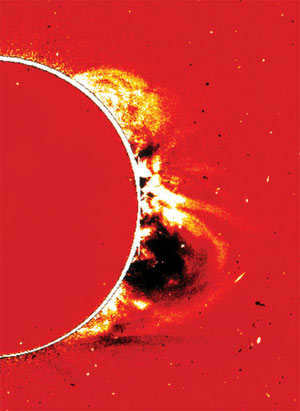

The sun’s core, despite its immense size, generates approximately 100 billion megatons of TNT equivalent every second. In comparison, the human body produces heat 200,000 times more vigorously. Image from Popular Mechanics
The CNO cycle reactions within the Sun are relatively slow and contribute only 1.5% of the total energy output. Nevertheless, they should not be disregarded, as failing to account for them would result in an underestimation of the calculated power of the solar neutrino flux. The enigmas surrounding the Sun’s neutrino emission are highly intriguing, but they delve into a separate realm that lies beyond the scope of this article.
The central region of the young Sun contained 72% hydrogen, but according to model calculations, it now constitutes only 35% of the mass in the core’s central zone and 65% in the peripheral zone. Unfortunately, even the nuclear fuel is being consumed. However, there is enough fuel remaining to sustain the Sun for another billion years, which will give us another five years. Some people compare the processes occurring in the Sun’s thermonuclear furnace to the detonation of a hydrogen bomb, but this comparison is only tentative. The core of a hydrogen bomb, which weighs tens of kilograms, has the explosive power of megatons of TNT, while the solar core, despite its enormous mass, only produces about a hundred billion megatons per second. It is easy to calculate that the average power of energy release is six microwatts per kilogram, which is 200,000 times less than the heat produced by the human body. Solar fusion does not “explode,” but rather burns slowly, which is fortunate for us.
Radiative transfer
The core’s outer edge, located approximately 150,000 km away from the Sun’s center (0.2 of the Sun’s radius), experiences a temperature decrease to 9 million degrees Celsius. As the temperature cools further, the proton-proton cycle reactions cease to occur, as the protons lack the necessary kinetic energy to overcome the electrostatic repulsion and merge into a deuterium nucleus. The CNO-cycle reactions also do not occur in this region, as their temperature threshold is even higher. Consequently, solar thermonuclear fusion comes to a halt at the nucleus’s boundary.
The central region of the sun is encompassed by a robust spherical layer that terminates at a vertical demarcation of 0.7 times the radius of the sun. This region is known as the radiative zone. Radiative zone). It is filled with a mixture of hydrogen and helium plasma, with the density gradually decreasing by a factor of one hundred, from 20 to 0.2 g/cm 3 , as it extends from the inner boundary to the outer boundary of the zone. Despite the fact that the outer layers of plasma are colder than the inner layers, the temperature gradient is not steep enough to generate vertical currents of material, which would transport heat from the lower layers to the upper layers (this process of heat transfer is referred to as convection). In the supranuclear layer, convection does not and cannot occur. Instead, the energy released in the core is transmitted through this layer in the form of electromagnetic radiation quanta.
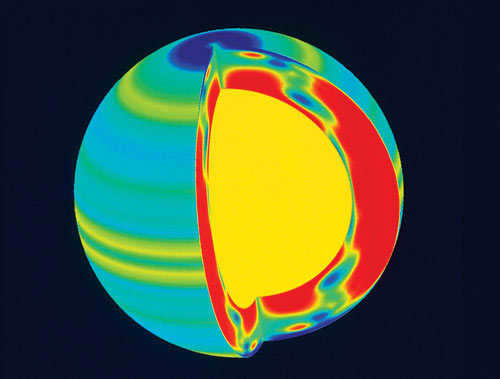
What is the process behind this occurrence? Gamma particles that originate at the core of the nucleus scatter throughout its substance, progressively losing their energy. Eventually, they reach the outer limits of the nucleus in the form of soft X-rays, which have a wavelength of approximately one nanometer and an energy range of 400-1300 eV. The plasma in this region is mostly impenetrable to these X-rays, only allowing them to travel a short distance of less than a centimeter. Upon colliding with hydrogen and helium ions, the gamma particles transfer their energy to these particles. Some of the transferred energy is used to maintain the kinetic energy of the particles at the same level, while the rest is emitted as new particles with longer wavelengths. As a result, the photons gradually disperse throughout the plasma, undergoing a continuous cycle of depletion and regeneration. The stray particles tend to move upwards more easily, as the density of matter decreases in that direction. Consequently, the radiant energy flows from the inner depths of the zone towards its outer boundary.
The Convection Zone
The convection zone begins at a radius depth of 0.3 and extends all the way to the surface of the Sun (or more accurately, its atmosphere). The bottom of the convection zone is heated to temperatures as high as 2 million degrees, while the outer boundary remains relatively cooler at below 6000°C. A thin layer called the tachocline separates the convection zone from the radiant zone. The tachocline is where the most fascinating and yet not fully understood phenomena occur. It is believed that the plasma flows within the tachocline play a significant role in shaping the solar magnetic field. Approximately two-thirds of the Sun’s volume is occupied by the convection zone. However, its mass is relatively small, accounting for only two percent of the Sun’s total mass. This is expected because as solar matter moves away from the center, it naturally becomes less dense. At the lower boundary of the convection zone, the plasma density is only 0.2 times that of water, and as it reaches the atmosphere, it decreases to a mere 0.0001 times the density of Earth’s air at sea level.
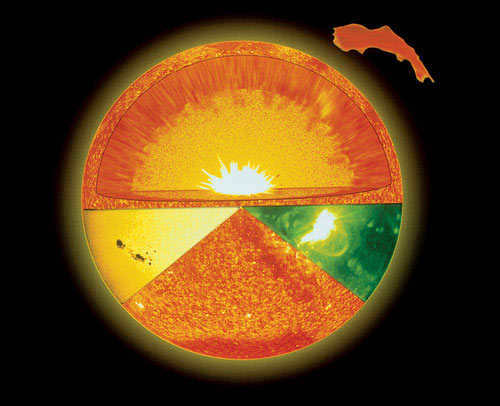
The composition of the atmosphere
The arrangement of the atmosphere is quite intricate. The lower level, known as the photosphere, is where all sunlight escapes into space. The main source of light is the 150 km thick layer within the photosphere. In total, the photosphere has a thickness of about 500 km. Along this vertical line, the plasma’s temperature decreases from 6400 to 4400 K.
Within the photosphere, there are constantly appearing areas with reduced temperatures (down to 3700 K), which emit weaker light and are observed as dark spots. The number of sunspots varies in an 11-year cycle, but they never cover more than 0.5% of the solar disk’s area.
The chromospheric layer is located above the photosphere, and even higher is the solar corona. The solar corona has been known to exist for centuries, as it is clearly visible during total solar eclipses. The discovery of the chromosphere, on the other hand, is relatively recent and was made in the mid-19th century. On July 18, 1851, a large number of astronomers gathered in Scandinavia and neighboring countries to observe the Moon passing in front of the sun. Just a few seconds before the total phase of the eclipse ended, scientists noticed a bright red crescent at the edge of the solar disk. During the 1860 eclipse, researchers were able to observe these flashes more closely and even obtain spectrograms of them. It was not until nine years later that English astronomer Norman Lockyer named this region the chromosphere.
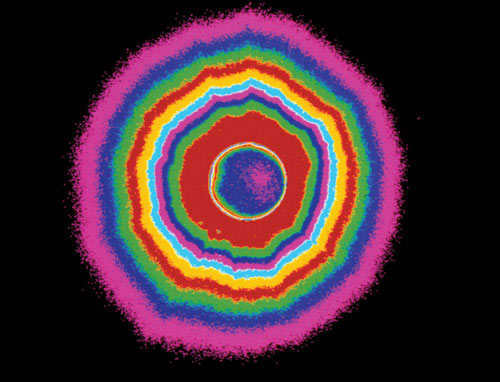

The Solar Corona
An image of the solar corona (with synthetic colors, the blue with pink spot in the center represents the Moon) captured during a complete solar eclipse on February 26, 1998. The solar corona is the outer layer of the sun’s atmosphere, composed of thin hydrogen gas that is heated to temperatures reaching one million degrees Celsius. This image was featured in Popular Mechanics.
The corona, which can reach temperatures of several million degrees Celsius, is the most scorching region of the atmosphere. Multiple models based on magnetic hydrodynamics attempt to explain this phenomenon, but unfortunately, these processes remain highly intricate and poorly comprehended. Additionally, the corona is filled with a diverse array of structures, including holes, loops, and streamers.
Challenges with Solar Energy
Despite the fact that the Sun is the largest and most prominent object in the Earth’s sky, there remain numerous unresolved issues in the field of solar physics. “While we are aware that the Sun’s magnetism exerts a remarkably strong influence on the dynamics of its atmosphere, such as the formation of sunspots, the exact mechanisms by which it arises and propagates within the plasma have yet to be fully elucidated,” states Stephen Kale, the Director of the American National Solar Observatory. “A close second would be deciphering the mechanisms behind solar flares. These brief yet immensely powerful bursts of fast electrons and protons, accompanied by the generation of equally potent streams of electromagnetic radiation across various wavelengths, still lack rational models to explain their occurrence. Lastly, it is crucial to comprehend the means by which the photosphere energizes and heats the corona to temperatures three orders of magnitude higher than its own temperature. To achieve this, the accurate determination of magnetic field parameters within the corona is of utmost importance, as these values remain partially unknown.”
Solar Flares
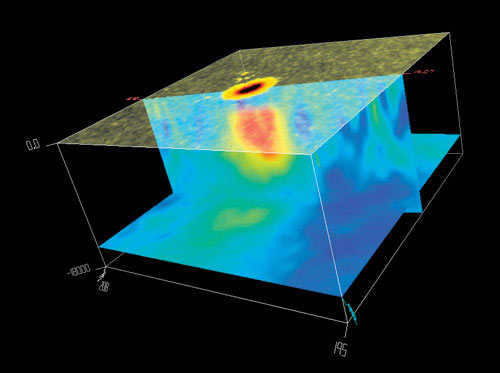
A sunspot’s three-dimensional model has been created using data from the SOHO space observatory. The upper plane represents the surface of the Sun, while the lower plane extends to a depth of 22,000 km. The vertical section plane is extended to 24,000 km. Different speeds of sound are indicated by the colors (ranging from red to blue and black). The image has been sourced from Popular Mechanics.
“Studying the magnetism of the sun will provide valuable insights for two telescopes currently under construction in California and the Canary Islands,” Kale explains. – Additionally, we have plans to commence the construction of a cutting-edge four-meter telescope for solar research in the upcoming year. Furthermore, we are eagerly anticipating the launch of the Solar Dynamics Observatory, a robust satellite equipped with state-of-the-art instruments designed for a comprehensive examination of the solar atmosphere. This highly anticipated launch is scheduled for late this year or early next year.”
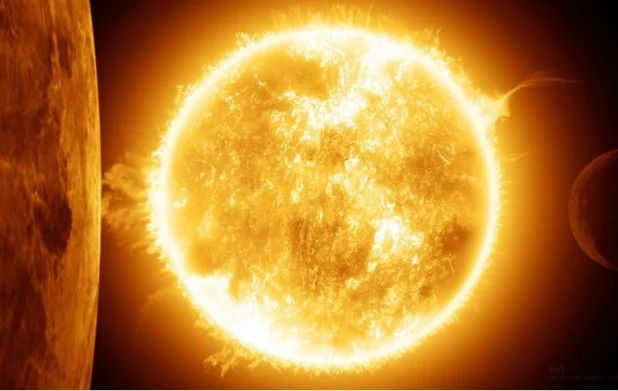
The Earth greatly depends on the Sun. Not only does it give light and heat to the inhabitants of the planet, but it also maintains the Earth’s position in its orbit, preventing it from drifting off into the unknown expanse of outer space. With its immensely high temperature, the Sun is a luminous sphere of flames, illuminating even the most remote celestial bodies within our solar system.

Living in a rapidly changing society, it is no longer sufficient to solely rely on the education provided in schools. It is crucial to obtain valuable insights into finance and investments in order to secure one’s financial stability.
Shape your future by augmenting your knowledge and skills today through the online platform for FINANCIAL LITERACY.


Register now, APPLY FOR YOUR SUCCESS
Unique Traits of the Sun
Located at the heart of our solar system is an average-sized dwarf star known as the Sun, classified as a G2 spectral class. It is situated approximately 150 million kilometers away from our planet. In just 8 minutes, light, which travels at a speed of 300,000 kilometers per second, covers this vast distance. Due to the Sun’s relatively close proximity to Earth, scientists have an exceptional opportunity to investigate the phenomena occurring within it. Furthermore, these observations enable scientists to draw conclusions about similar processes occurring in stars that are situated much farther away. The Sun is a stellar object that can be observed by the human eye without any aid. Through extensive research conducted by astronomers, a comprehensive understanding of the Sun as a celestial object has been achieved.
- The nucleus is situated right at the center of the star. It possesses a radius of 150,000 kilometers. This is the location where the main thermonuclear reactions occur. Given the considerable size of the core, the density of its substance is 150 times higher than that of water. The temperature within the core reaches a staggering +13.5 million degrees Celsius. It generates the energy that the Sun emits. The remaining sections of the star are heated by the core, as they do not generate any energy on their own.
- The region of radiative transfer – This is the area where photons move in a disorganized fashion. It takes approximately 170 thousand years for them to reach the subsequent layer. The upper boundary of this zone follows the shape of a sphere with a radius of approximately 490 thousand kilometers. Within this region, the temperature decreases from +7 to +2 million degrees.
- The convective zone is located in the outer region and is estimated to be 200,000 kilometers thick. It has a temperature of approximately 6,000 degrees Celsius. This region is characterized by the movement of plasma due to convection, with gas streams reaching velocities of 6 km/s.
- The solar atmosphere is composed of three parts:
- the photosphere;
- the chromosphere;
- the corona.
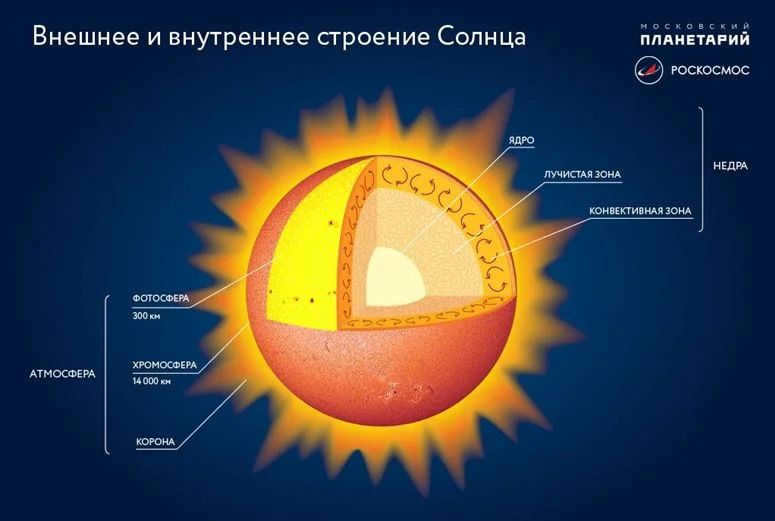
Source
Mass, temperature, and composition of the Sun
The Sun has a mass of approximately 2*10kg 3 , accounting for 99.866% of the total mass of the Solar System when excluding space dust. Its luminosity is 3.86*10 23 kW, and the temperature of the photosphere is around 6,000 degrees Celsius. Given this extreme temperature, the Sun’s composition is predominantly in the form of constantly moving red-hot gases, as it cannot exist as a solid or liquid. This incredible sphere, with a radius of 696,000 kilometers, has an average density of 1.416*10 3 kg/m 3. The temperature on the Sun’s surface varies at different points, with the temperature of the matter increasing towards the core and reaching +15 million degrees near the center of the Sun.
According to the research findings, hydrogen makes up approximately 73.5% of the composition of the Sun. Helium accounts for about 24.9%, while the remaining elements only contribute around 1.5% to the star’s total mass. The gas giant planets in our solar system have a similar chemical makeup. Interestingly, there is no chemical element in the Sun that cannot be found on Earth, indicating that all celestial bodies in our solar system are indeed formed from the same substance. However, these elements can form different compounds and exist in various states.
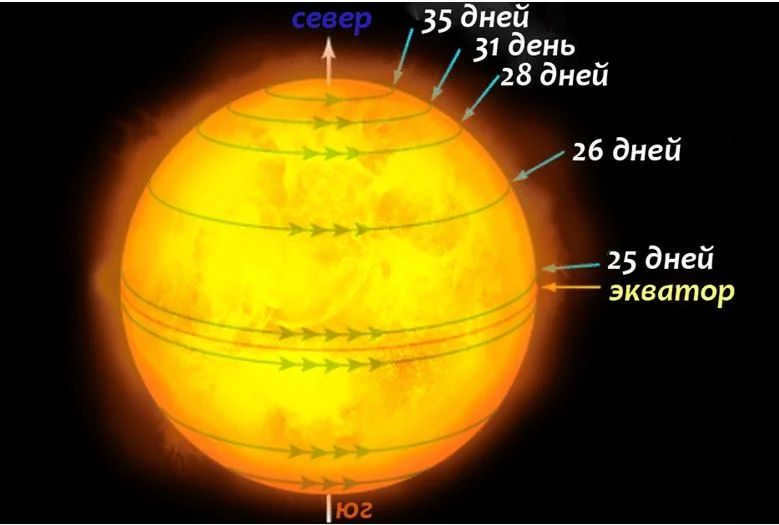
Source
The boundaries of the Sun are challenging to determine due to its matter being in a plasma state. At such high temperatures, molecules move at such rapid speeds that a solar atmosphere forms above the surface, extending far into space and creating “strands” of varying lengths.
Centuries before the invention of telescopes, observers noticed occasional large, irregularly shaped dark spots appearing on the Sun’s surface. With the advancement of science and technological tools, it became evident that these “decorations” are always present on the star, but they continuously change. Some spots emerge and vanish quickly, while others can persist for several days or even months.
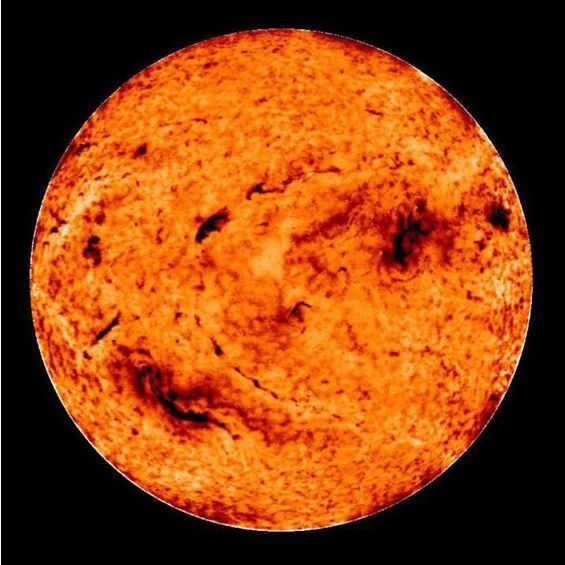
By observing the Sun, one can witness the shifting of spots on its surface. This discovery has led scientists to the realization that our Sun is not stationary in space, but rather in a state of rotation. By studying the speed of these spot movements, researchers were able to determine the Sun’s rotational period. Through these calculations, it was determined that different regions of the Sun rotate at varying rates, ranging from 25 to 35 days.
Approximately after five years, the year of maximum arrives once again. On average, this cycle lasts for 11 years, but there are instances when its duration can either be prolonged or shortened. Scientists have observed cycles ranging from 8 to 15 years. Intriguing formations can often be observed near sunspots and at the periphery of the solar disk. These formations appear exceptionally bright, much brighter than the rest of the photosphere, and have a slightly elongated shape. They are known as flares. The temperature of these formations is typically 2,000 degrees Celsius higher than the surrounding environment, and flares are not uniform in structure. Each of them contains a denser and hotter “rod” that can reach sizes of up to 30,000 kilometers. Naturally, this region emits more light than the edges of the flare.
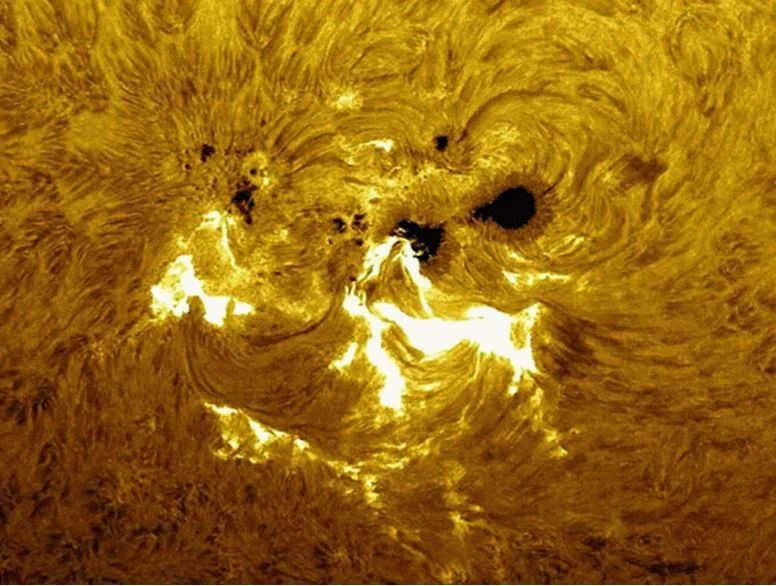
Photospheric flares are clusters of bright granules that typically encircle a cluster of sunspots. The collective area of these clusters is several times larger than that of the sunspots themselves, and they persist for longer periods of time. During periods of high solar activity, these flares can occupy up to 10% of the entire solar surface.
The structure of the solar atmosphere
Every planet in the solar system possesses its own unique atmosphere. Similarly, the Sun, like other stars, also possesses outer layers known as atmospheres. The solar atmosphere is characterized by its own distinct structure and features. It is composed of:
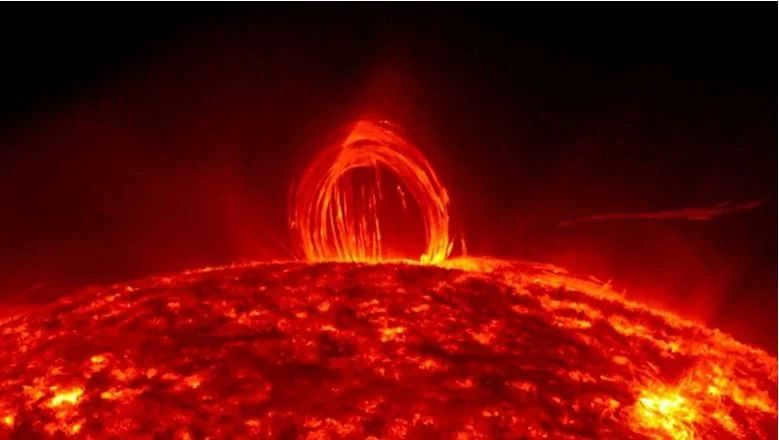
Protuberances
Prominences are relatively large formations of cool gas (compared to the surrounding surface of the Sun) that create the solar corona. In simpler terms, they are fiery bursts attempting to break free from the chromosphere.
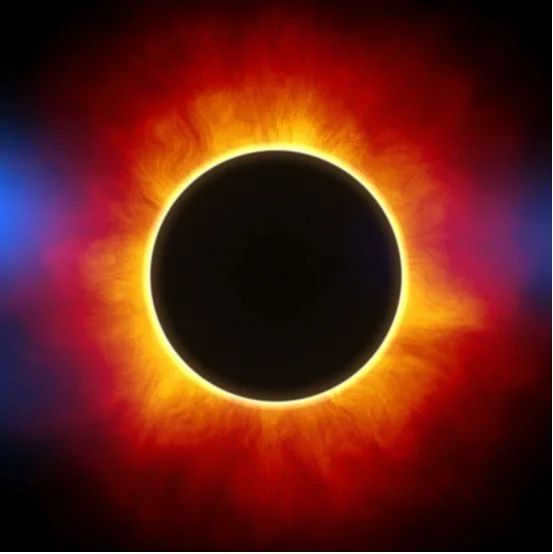
The chromosphere becomes readily apparent during a complete solar eclipse, where it is easily visible as a bright ring surrounding the dark silhouette of the Moon as it passes in front of the Sun. The chromosphere spans a distance of 10,000 to 15,000 kilometers and is characterized by significantly higher temperatures than the photosphere. In contrast, the density of the chromosphere is much lower.
The origin of the Sun’s power
The Sun, like other stars, derives its energy from the conversion of hydrogen into helium in its core. This process, known as thermonuclear fusion, involves the merging of light atomic nuclei to form heavier ones and releases a significant amount of energy. Within the Sun, this energy is transported through radiation, while in the outer layer, it is carried by convection of the plasma.
The Earth relies heavily on the Sun for its existence. Without the Sun, life would not be possible on our planet. Both humans and even the tiniest organisms are dependent on the Sun’s warmth and light, which sustains and illuminates the Earth. The Sun plays a crucial role in shaping the ecological dynamics of our planet, influencing the changing seasons and creating distinct climatic zones. Sunlight is essential for the process of photosynthesis, enabling green leaves to produce oxygen, a vital element for life.
However, the planets located within the solar corona, including our Earth, experience a unique impact from the solar wind. As the solar wind approaches Earth, it concentrates around the magnetic poles of the planet. This influx of particles penetrates the layers of the atmosphere and influences the Earth’s magnetic field. These fluctuations, known as magnetic storms, are particularly prevalent during periods of maximum sunspots, flares, and eruptions. Coincidentally, these periods also coincide with an increased likelihood of severe thunderstorms on our planet.
Magnetic storms have a detrimental effect on various devices and systems. Compasses lose their accuracy in determining north, and radio waves may experience interruptions. Television and radio equipment are also prone to malfunctions. Additionally, the well-being of some Earth inhabitants may significantly deteriorate during these storms.
Earth processes are not only affected by magnetic storms. The climate, for instance, is greatly influenced by solar activity cycles that last for half a century. Researchers have determined that outbreaks of highly dangerous infectious diseases tend to occur right after periods of intense solar activity. On average, this happens once every 11 years. This same cycle can also be seen in crop yields, animal populations, and migration patterns. Additionally, cardiovascular diseases tend to worsen and sudden deaths become more common during periods of solar activity.
The magnetic field of the Sun is believed to originate beneath the upper layer of the photosphere. It is this magnetic field that is thought to have an impact on all the processes taking place in the solar atmosphere, including solar flares. Without the presence of magnetic fields, the celestial luminary may not have garnered as much interest from mankind.
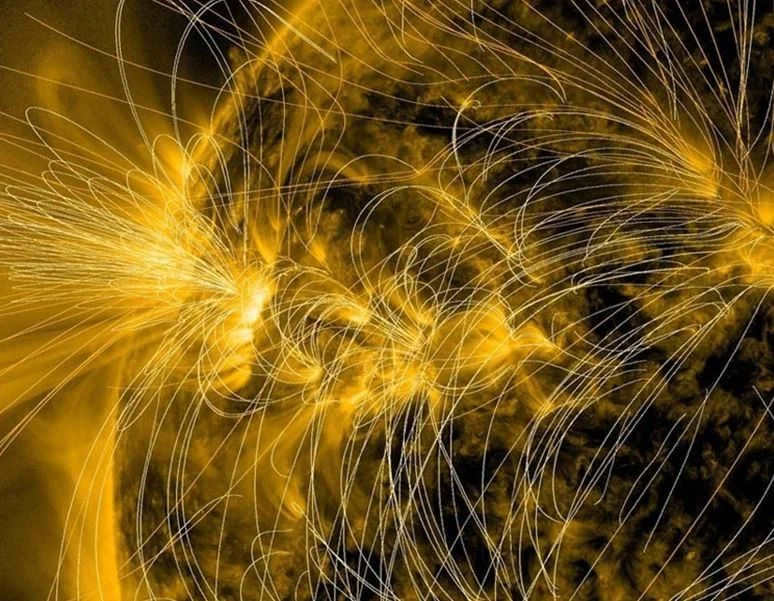
Magnetic fields have an effect on the creation of sunspots, which are areas where magnetic loops can extend across the entire surface of the Sun. In these sunspot regions, the magnetic field is consistently strong, with a tension that is a thousand times greater than in other areas. This strong field deflects charged particles in the plasma and prevents the formation of convection currents. As a result, the rise of hot gas is halted in the sunspot region, leading to lower temperatures. On the other hand, in the region of solar prominences, the magnetic field is not as strong and is unable to impede vertical convection flows of plasma. The variability of magnetic fields directly affects the cyclicity of solar activity. Interestingly, the seemingly floating prominences are actually held together by thin threads of the magnetic field.
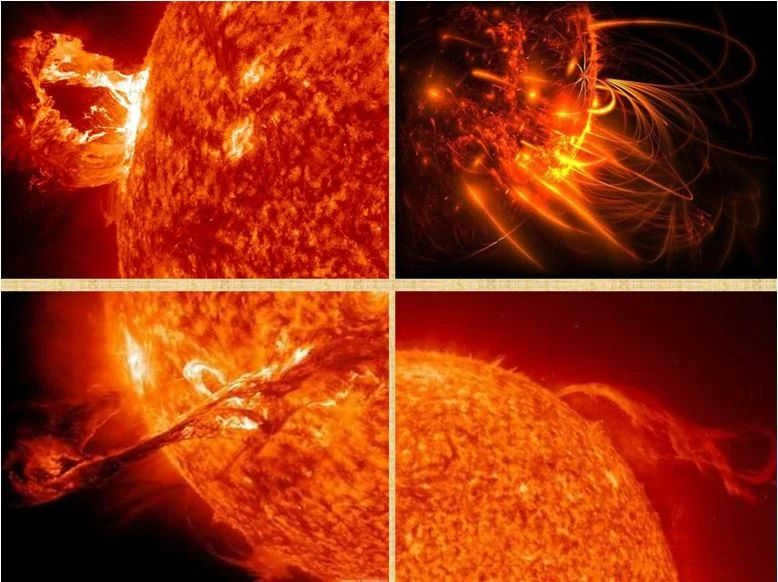
Prominence formation Source
Discovering the Sun
The Sun has captivated and intrigued humanity for thousands of years. It has been the subject of myths, tales, and legends. People from ancient civilizations referred to the Sun by different names such as Sol, Surya, Solvenel, Utu, Ra, and Shamas. Some even portrayed it as a chariot ascending to the sky. The Sun was worshipped, and civilizations like the Maya, Aztecs, and Incas believed that human sacrifices were necessary for its appeasement.
Temples and palaces were erected in honor of the Sun. Even today, stone megaliths can be found in England, Ireland, Malta, and Egypt, which were used to determine the summer and winter solstices. However, primitive methods of studying the Sun provided limited and unreliable information about the star, as it was seen as a divine entity.

Stone megaliths in England
The appearance of the first scientific papers did not occur until the 1st millennium BC. – The Babylonian sages made observations and recorded that the celestial luminaries move in an uneven manner along the ecliptic.
In the 5th century B.C., there was a debate about the nature of the Sun, with some arguing that it was a sphere of fire and its light was reflected from the surface of the Moon. Two hundred years later, Eratosthenes made calculations and estimated the distance from the Earth to the Sun to be between 148-153 million kilometers.
A significant breakthrough in astronomy occurred when Nicolaus Copernicus proposed the heliocentric model of the universe, in which the Sun was recognized as the center. Then, in the 17th century, after the invention of the telescope, the first details of the stars were able to be observed and documented.
During the 1980s, scientists conducted research on X-rays, gamma rays, and UV rays. From 1991 to 2001, the Yohkoh satellite closely observed solar flares. In 1995, the SOHO space observatory began its operations, but in 2010 it was replaced by the SDO.
However, the study of the Sun does not stop there, as the future of humanity depends on its activity. It is common knowledge that the Sun’s activity has an impact on Earth in various ways. Being a powerful source of radiation, we are protected from its harmful effects by the Earth’s magnetic field. In the near future, there are plans to launch probes that will continuously monitor and document all changes occurring on the Sun, while also measuring the particles and energy emitted by the solar corona.
A neutrino telescope is necessary for the exploration of the cosmos and the investigation of the origins of high-energy radiation in outer space.
A neutrino, an elementary particle with an incredibly weak interaction with matter, possesses the remarkable ability to traverse the Earth in mere seconds without any discernible effect. The discovery and study of neutrinos have revolutionized astronomical research. Neutrinos can effortlessly penetrate through any material, remain unaffected by interstellar dust, and are impervious to magnetic fields. Countless trillions of these particles pass through humans every second, completely unnoticed. Stars and planets serve as the primary sources of neutrinos in the vast expanse of outer space.
Currently, there are numerous initiatives underway to develop telescopes, including the Baikal Neutrino Telescope.
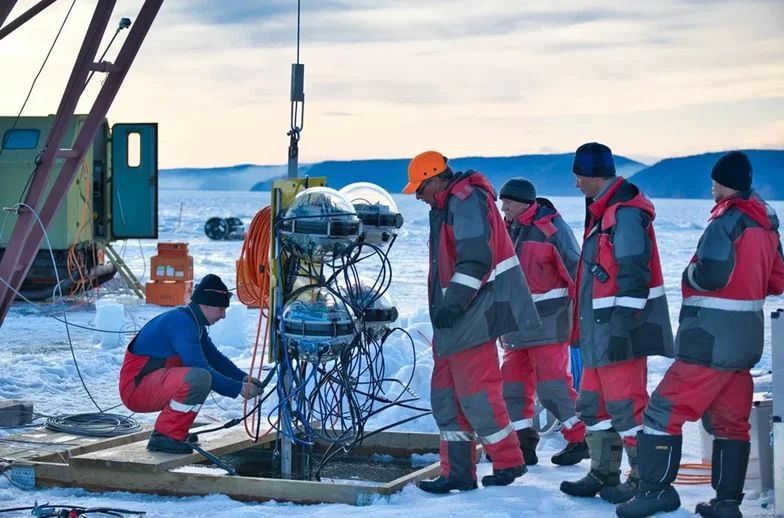
The Baikal Neutrino Telescope is being built.
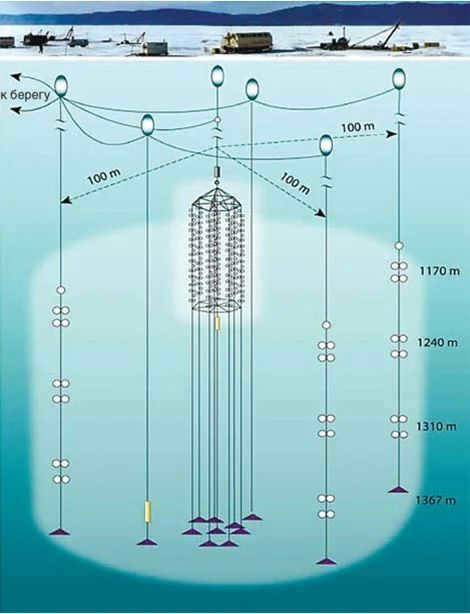
Diagram of a single cluster from the Baikal Neutrino Telescope Source
Currently, a total of 1440 optical modules have been deployed across 5 clusters. The project is set to be completed by 2021, making it one of the largest installations worldwide.

Optical module
There is another neutrino telescope situated in Antarctica, known as IceCube, which holds the distinction of being the largest in the world. In the year 2013, it successfully detected the first high-energy neutrinos, originating from sources far beyond our solar system. Additionally, there is a neutrino telescope located in the Mediterranean Sea. The ultimate goal is for all three telescopes to form part of the International Neutrino Observatory, leading to groundbreaking advancements in the field of space exploration, particularly in relation to the Sun.
The Sun continues to present numerous enigmas that must be unraveled by future generations of scientists. As the celestial body responsible for providing light and heat, it remains an inexhaustible subject of study.
Our Sun, the most extensively investigated star, holds immense value to us as it sustains life on Earth. Throughout the course of its observation, what knowledge have we gained about this extraordinary star?
How to Observe the Sun Safely
The Sun’s energy is an essential part of our lives, but it’s important to know how to observe it safely. If we were to harness the total power of the Sun and focus it on Earth using a massive space reflector, the consequences would be catastrophic. In just 4 minutes, all the water in our oceans would not only boil, but evaporate into outer space. This is a testament to the immense power of solar radiation. Furthermore, within 10 days, the entire planet would be completely vaporized. It’s a stark reminder of the importance of understanding and respecting the Sun’s power.
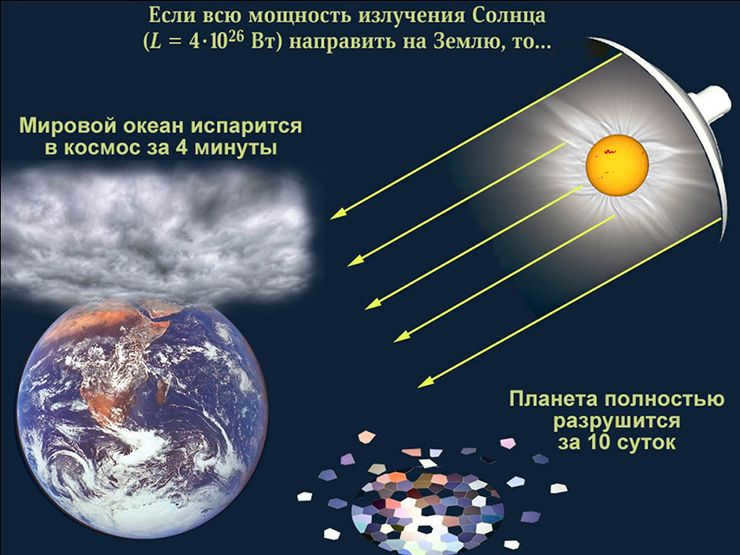
Fortunately, only a minuscule portion of the sun’s radiation actually reaches us, which means that the Earth and its inhabitants are not significantly affected by it. However, it is important to note that direct exposure to sunlight can be extremely harmful to your eyesight. While it may be tempting to glance at the sun briefly and then avert your eyes, it is strongly advised against. Even during a solar eclipse, it is not safe to stare at it for an extended period without proper eye protection. Regular sunglasses will not suffice; instead, specialized glasses with a heavily dense light-blocking film are necessary. These glasses weaken the intensity of the light by about a thousand times, ensuring that your retina remains unharmed during observation.

When it comes to observing the Sun through a telescope, caution is of utmost importance due to the inherent danger involved. Telescopes are equipped with a large lens that collects light and directs it straight into the observer’s eye. In fact, astronomers jest that one can only gaze at the Sun through a telescope twice in their lifetime – once with the right eye and once with the left eye. If one were to peek through the eyepiece even for a split second, it would be game over. To mitigate this risk, a special eyepiece has been developed, featuring a mirror that redirects 99.99% of the light sideways, away from the observer and towards an area of the observatory where people are not present. Consequently, only a small fraction of the light reaches the observer’s eye, allowing for safe viewing of the Sun’s surface.

However, if you ever find yourself in the position of having to look through the eyepiece of a large telescope, it’s important to be aware that it can be potentially unsafe. You should take note of the fact that there is a smaller telescope, known as a guide or finder, positioned parallel to the main telescope’s axis, and it has its own separate eyepiece. When I was in school, I used to observe the Sun using this type of telescope, projecting its image onto a white screen, which is a very convenient and safe method. However, on one occasion, I made the mistake of forgetting to close the lens of the finder. Suddenly, I detected the scent of burning and quickly realized what had happened, promptly moving away from the telescope. As a result, I ended up with a burned hole in the back of my coat, which served as a lasting reminder of the potential dangers. This incident serves as a reminder that even a small telescope, when focused on the Sun’s rays, has the ability to cause significant harm.

One can easily observe the Sun without the need for a telescope. By using a piece of paper or cardboard, a hole can be created using a needle, resulting in a pinhole camera that provides a precise representation of the Sun. This method allows people to safely observe eclipses without any potential dangers.

If you happen to possess a compact telescope lacking specialized light filters, there is a convenient way to observe the solar eclipse. Simply position a screen at the eyepiece and project the image onto it. As the Moon passes in front of the Sun, you can safely photograph the various stages of the eclipse without harming your eyes.
The Sun’s Visible Phenomena
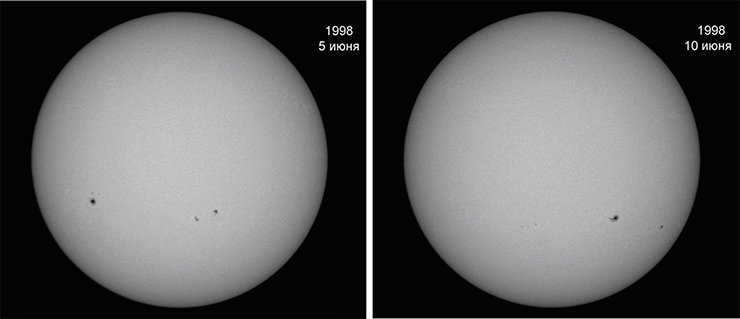
The surface of the Sun is not uniform as it may initially appear: we can observe some spots on a bright background. Furthermore, if we continuously capture images or make sketches of the Sun, we can observe the movement of these spots. This leads us to two conclusions: firstly, the Sun undergoes rotation, and secondly, different regions of the Sun have varying temperatures. While the typical temperature of the Sun is around 6000 K, the spots are noticeably cooler, measuring approximately 4000 K according to measurements. Although this temperature difference may seem small, it is important to remember that emissivity is directly proportional to the 4th power of temperature. Additionally, the spectrum of the Sun shifts from visible light to infrared, and infrared rays have a harder time penetrating the Earth’s atmosphere and being detected by photodetectors. This is why sunspots appear so dark.
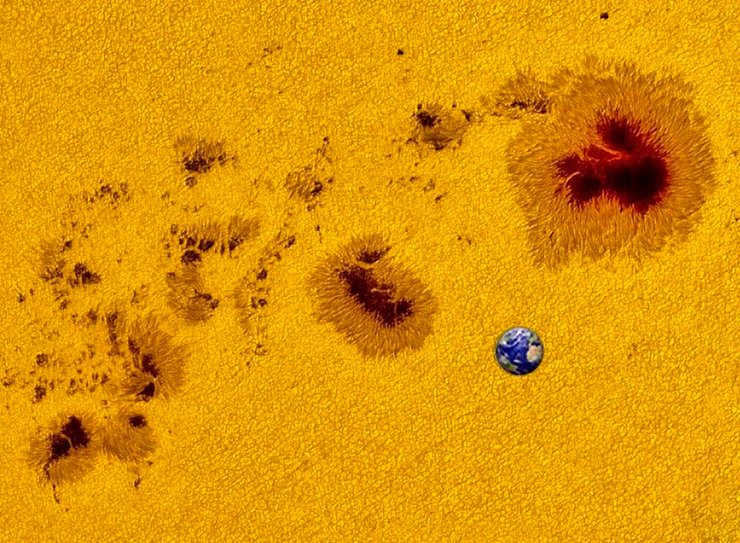
The magnitude of sunspots is astounding. There are sunspots that are multiple times larger than the Earth. These spots are surrounded by a luminous photospheric surface where streams of hot gas constantly erupt. Against this backdrop, cooler spots are clearly visible, varying in brightness: astronomers refer to a sunspot as having a “core” (umbra) and a “surrounding region” (penumbra). The sunspot remains stable due to a strong magnetic field that prevents horizontal gas mixing within it. The particles of hot gas are ionized, essentially forming plasma, which moves in a peculiar manner within the magnetic field: it can move along the lines of force, but not across them, thus inhibiting the circulation of matter in transverse directions.
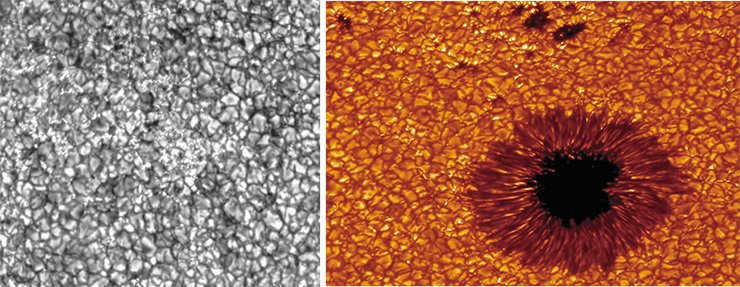
Understanding the Mechanisms of the Sun
When it comes to the inner workings of the Sun, we can envision its structure in the following manner: it consists of a central core, characterized by temperatures exceeding 5 million degrees Celsius, with the very center reaching approximately 15 million degrees Celsius. This core serves as the main source of energy, where thermonuclear reactions occur and release immense amounts of energy that is then transferred to the Sun’s outer layers. In stars, two transport mechanisms operate efficiently to facilitate this energy transfer.
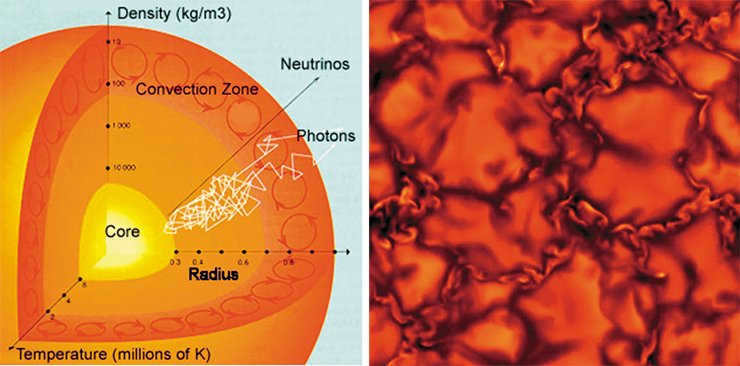
At a certain depth, the density and temperature of particles decrease to the point where they are no longer able to effectively transfer all the energy released within the nucleus. This is where convection, the mixing of matter, comes into play as a means of energy transfer: hot streams of gas rise, cool down, and then sink as they become less warm. It’s similar to when we heat water in a pot on the stove and it starts to boil.
In nature, there is another mechanism for energy transfer called heat conduction: in a solid object, molecules vibrate and push against each other, resulting in the kinetic transfer of heat. This process also occurs within the Sun, but it has a minimal role. However, there are stars, such as white dwarfs, where heat conduction is the primary method of transfer.
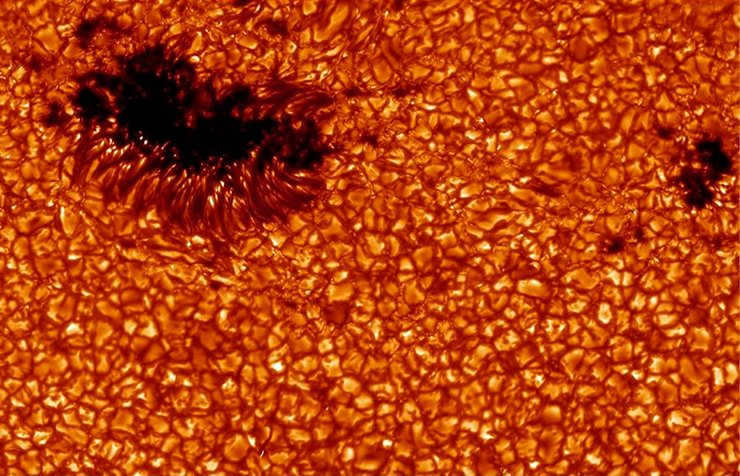
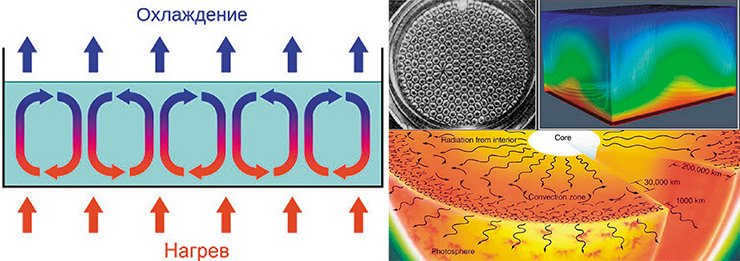
Close to the location, one can observe faint lines known as flares. Physicists should also be familiar with this occurrence: the hot plasma is unable to penetrate the spot area due to the magnetic field, but it must find a way to escape – and it does so nearby. These torches encircle every spot, but they appear more distinct at the Sun’s periphery.
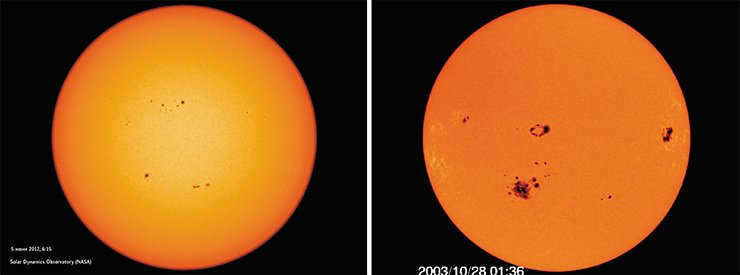
Ever since the 17th century, when Galileo first began observing the Sun, a record of solar activity has been maintained. The graph that displays the fluctuations in the number of sunspots or their overall area over time clearly demonstrates a periodic pattern: each maximum of solar activity is separated by approximately 11.5 years, allowing for the prediction of activity periods. This is of great significance, as during periods of heightened solar activity, there is an increased risk, particularly for space technology. Malfunctions occur more frequently, and the upper layers of Earth’s atmosphere become denser, among other effects.
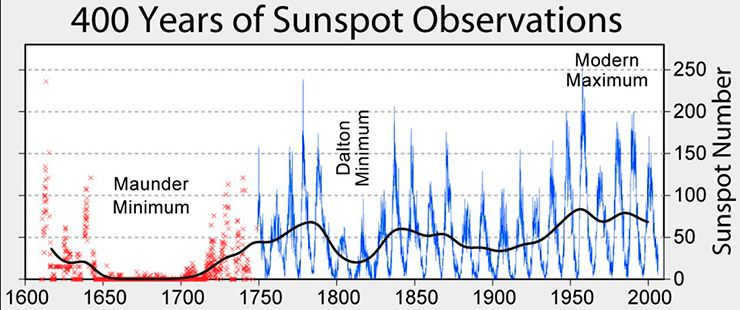
During the period known as the Maunder minimum, which occurred from the middle of the XVII century to the beginning of the XVIII century, there was a significant absence of sunspots, solar flares, and strong gas flows on the Sun. This lack of solar activity had a direct impact on Earth, leading to a period of cooling known as the little ice age. This can be seen in old Dutch paintings, which often depict people enjoying the popular winter pastime of ice skating on frozen canals. However, if one were to visit Holland in the present day winter, they would find that the canals no longer freeze over as they once did. Even if they were to freeze for a short period of time, it is unlikely that anyone would risk venturing out onto such thin ice.
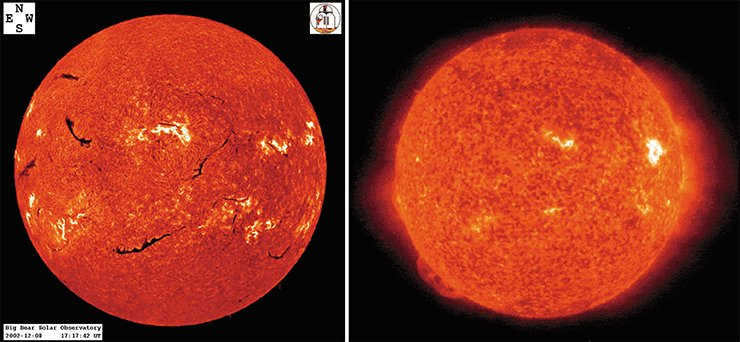
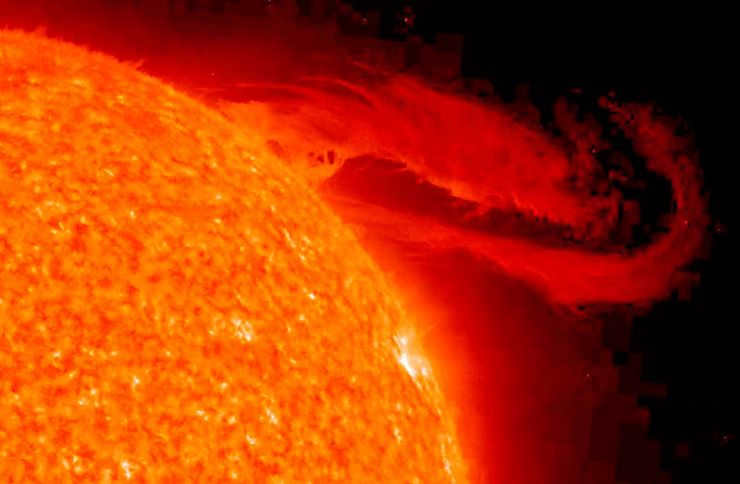
And the Sun looks absolutely amazing in certain segments of the ultraviolet spectrum, but these stunning images can only be captured by satellites: radiation with wavelengths less than 300 nanometers cannot penetrate the Earth’s atmosphere. In normal white light, the Sun appears serene, but when observed in the radiation emitted by ionized iron, its surface takes on a completely different appearance.
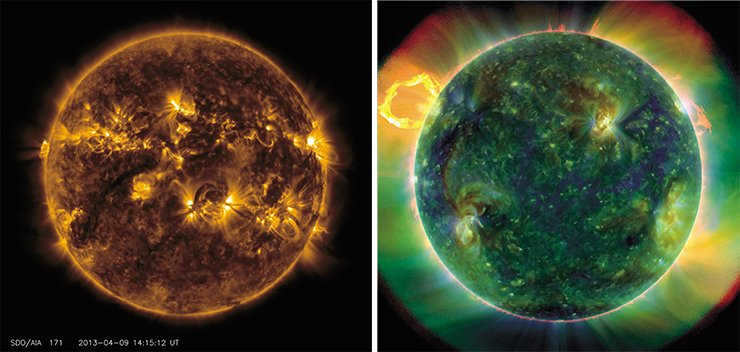
When observing a composite image created from multiple spectral lines, a wealth of information can be gleaned. Not only can we observe active regions, emission protuberances, and gas flows in the solar corona, but we can also detect individual bright points that were previously unnoticed. These images provide valuable insights into the functioning of the star’s surface.
What makes this even more fascinating is the ability to capture continuous images and create “multiviews” from these individual frames. For instance, the venerable SOHO space telescope, which has been orbiting for two decades, captures multiple images of the Sun every hour using a hydrogen emission line filter. By examining a series of these images, we can witness the development of flares and prominences, as well as observe the star’s rotation.
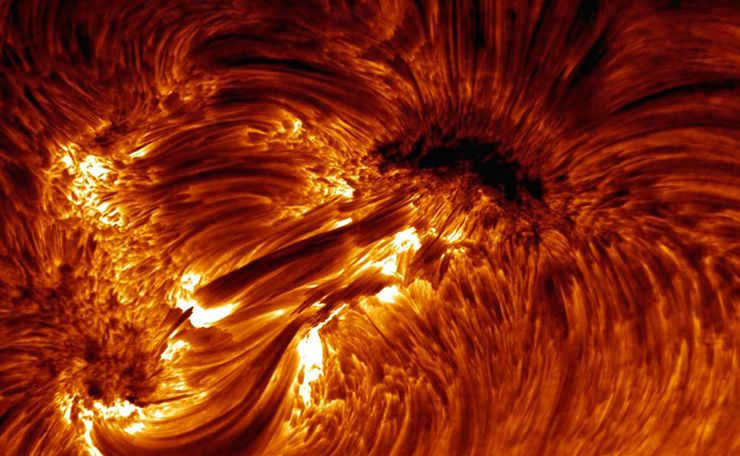
The Sun’s rotation speed is not particularly high: it takes about 27 days for it to complete one full revolution on its axis. However, there are stars that rotate much faster, completing a full revolution in just a few hours. The reason for the Sun’s relatively slow rotation can be attributed to the formation of our solar system. During this process, the planets “absorbed” a significant amount of momentum from the Sun, resulting in the majority of the solar system’s total momentum being carried by the planets themselves. This momentum is primarily derived from the planets’ orbital motion, with the massive planet Jupiter playing a particularly important role. As a result, if we observe a star that is rotating rapidly, it is likely that this star does not have any planets orbiting it.
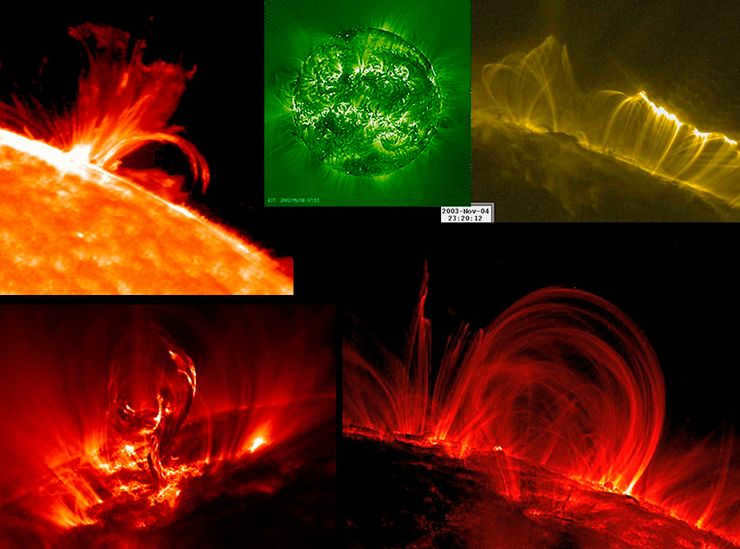
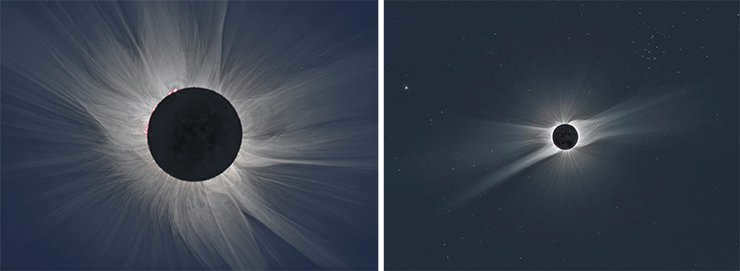
Now, let’s contrast the information we have: the Sun’s surface is heated to a mere 5-6 thousand degrees, but as we venture into the frigid expanse of space, temperatures suddenly soar into the millions. It’s a rather peculiar scenario, wouldn’t you agree? It appears as though heat is flowing from a heater to a refrigerator, with the Sun’s surface serving as the refrigerator in comparison to its core. What exactly brings energy to the core and heats up the corona?
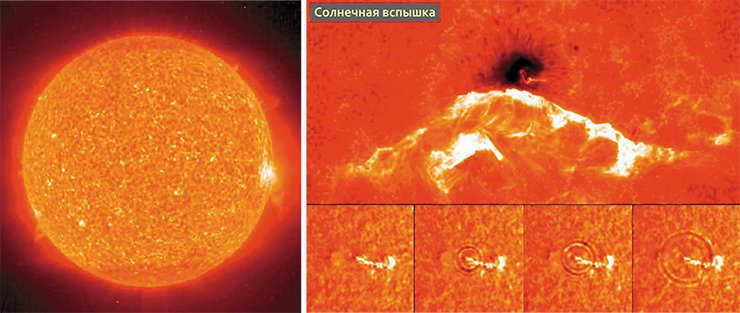
Until now, various theories have been proposed to explain the abnormally high temperature of the gas in the corona – including both sound waves and magnetic waves. Recently, however, astrophysicists have discovered the cause of this phenomenon: microbursts on the surface of the Sun. These microbursts are tiny bright spots that appear in the contact area between gas streams, resembling granules. However, these “micro” flashes are only small in comparison to the size of the entire Sun, and each flash releases an enormous amount of energy, equivalent to about a hundred megatons of trinitrotoluene (TNT). To put this into perspective, the most powerful bomb ever detonated by mankind, a hydrogen bomb, had an explosion energy of 50 megatons (which happened to be a domestic bomb). Despite the immense energy released by these microbursts, we refer to them as “nanoflashes” because they are nearly invisible on the Sun.
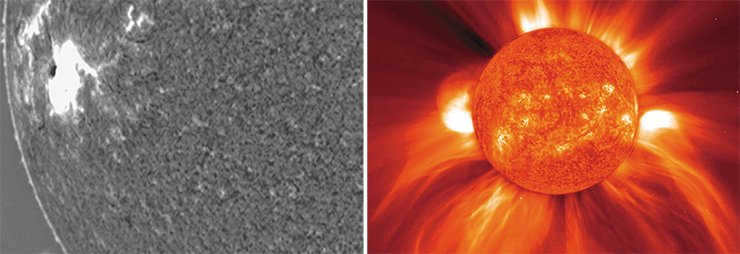
A flare is essentially an eruption of a magnetic bomb: magnetic fields compress the plasma flow, resulting in rapid heating. At this location, a disturbance occurs on the surface of the Sun, causing gravitational waves (similar to waves on water) to propagate. In other words, the flare acts as if it has struck the surface, generating a wave akin to a typical tsunami. Each flare releases enough energy to heat a substantial amount of plasma and eject it from the surface. However, it may not necessarily escape permanently as it can ascend and eventually descend back to the Sun due to the Sun’s gravitational pull.
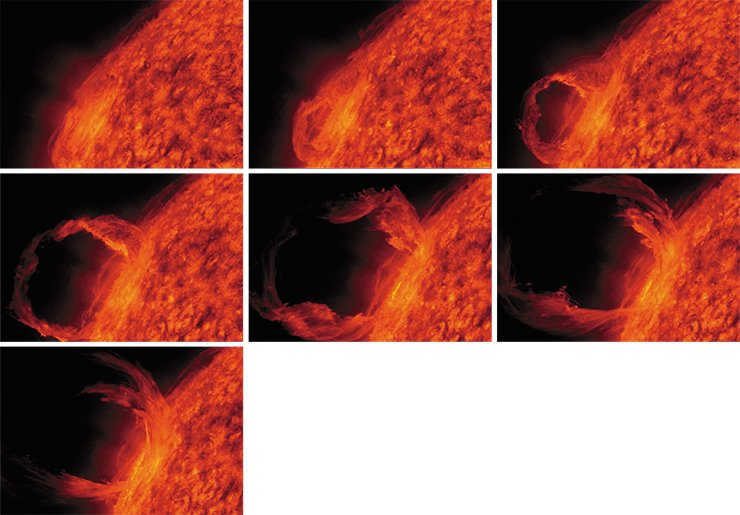
Occasionally, the cloud is expelled at a velocity of the second space, and these occurrences are referred to as “coronal mass ejections” which travel in various directions. In the event that a comet comes into contact with one of these ejections, its tail may be torn away. However, a new tail regenerates, much like a lizard’s tail, due to constant vaporization. The Earth is also affected by solar emissions. When a plasma cloud of this nature collides with our atmosphere, we witness the phenomenon known as the aurora borealis. Given the significance of these events, there are numerous satellites in operation today dedicated to monitoring solar marvels. Furthermore, polar lights can also be observed on the planets Jupiter and Saturn.
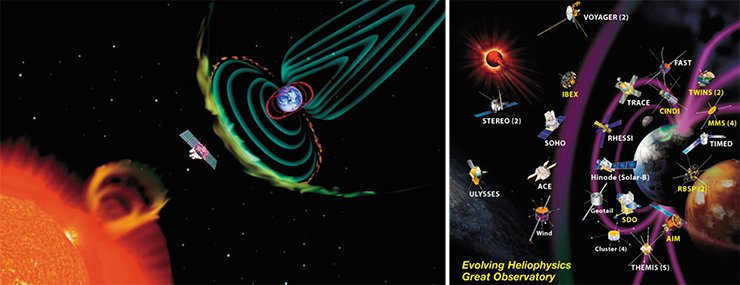
The lifespan of the Sun, much like everything else in this world, is finite. The duration of time that remains for it (as well as the Earth) to exist will be the main topic of discussion in the upcoming lecture.

Throughout history, the organization of our Galaxy has always been a topic of great importance. It is common knowledge that our solar system is comprised of eight planets that revolve around the Sun. However, in this piece you will also discover the movement of the Sun itself. Let us first grasp the concept of planetary motion.
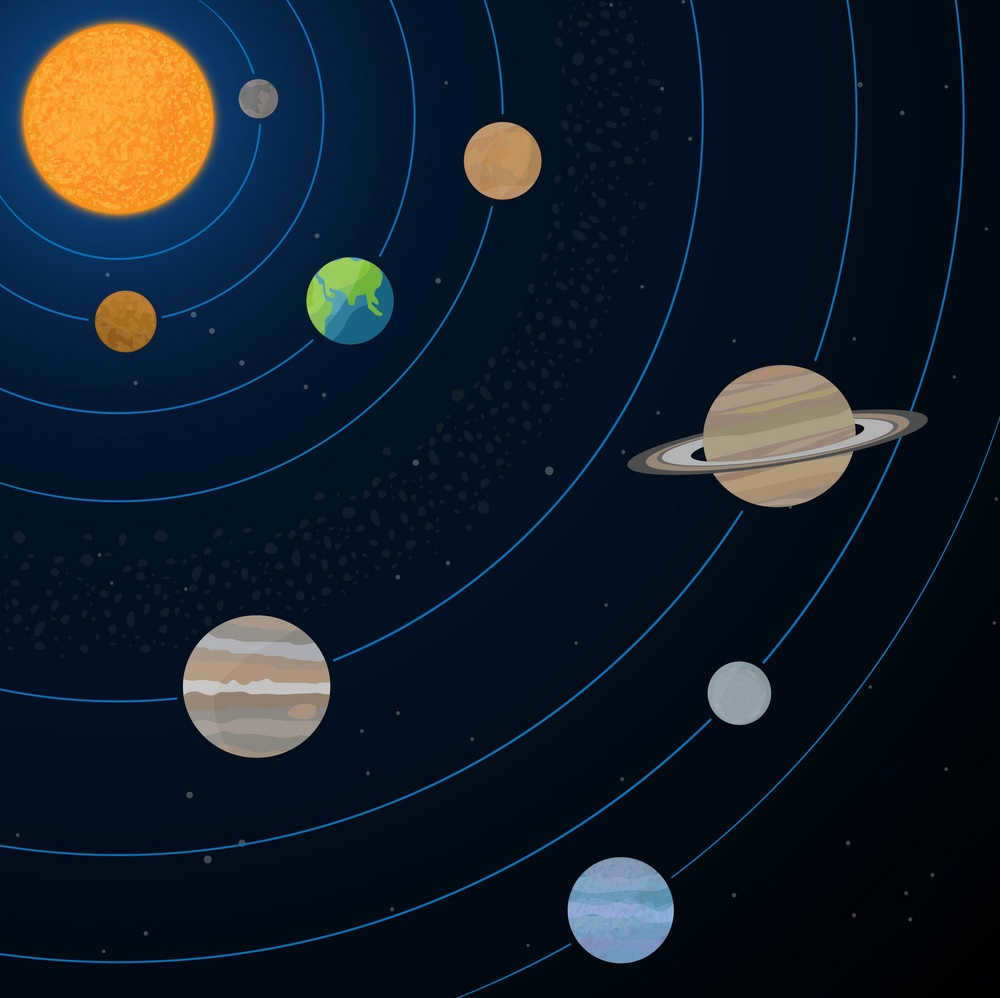
What causes the movement of planets around the Sun?
When we say that planets orbit the Sun, we mean that they are continuously moving in a circular path around it. This movement can be compared to the Moon or a NASA satellite orbiting the Earth. The reason behind this is that lighter objects tend to revolve around heavier ones, and in our solar system, the Sun is the heaviest object. It weighs 1000 times more than the largest planet, Jupiter, and over 300,000 times more than Earth. As a result, planets are celestial bodies that are constantly in motion around the Sun. In a similar way, the Moon and satellites orbit the Earth.

However, the question of why one thing revolves around another still remains. The explanations for this phenomenon are intricate, but the initial logical reasoning was provided by a renowned scientist. This scientist, Isaac Newton, who resided in England approximately three centuries ago, gained immense fame for his ability to answer perplexing and captivating scientific inquiries of his time.
Newton comprehended that the planets orbit the Sun due to the same reason objects fall towards Earth when released. Just as the Earth’s gravity pulls everything downward unless another force counteracts it and keeps us grounded, the Sun’s gravity attracts the planets. Heavier objects exert a stronger gravitational force compared to lighter objects. Therefore, as the heaviest entity in our solar system, the Sun exerts the most powerful gravitational pull.
The question that arises now is: why don’t the planets just fall and burn up if the Sun attracts them? Apart from being pulled towards the Sun, the planets also have a sideways motion. It’s similar to having a weight on a string. When you twist it, you continuously pull it towards your hand. Similarly, the gravity of the Sun attracts the planet, but its sideways motion keeps it spinning around. Without that sideways motion, it would fall towards the center. And without the pull towards the center, it would move in a straight line, which is exactly what would happen if you let go of the string.
The Milky Way is the center around which our galaxy rotates. Scientists have estimated that the Sun’s speed of rotation is approximately 828,000 km/h. However, despite this incredible velocity, it would still take 228 million years for one complete revolution around the Milky Way!
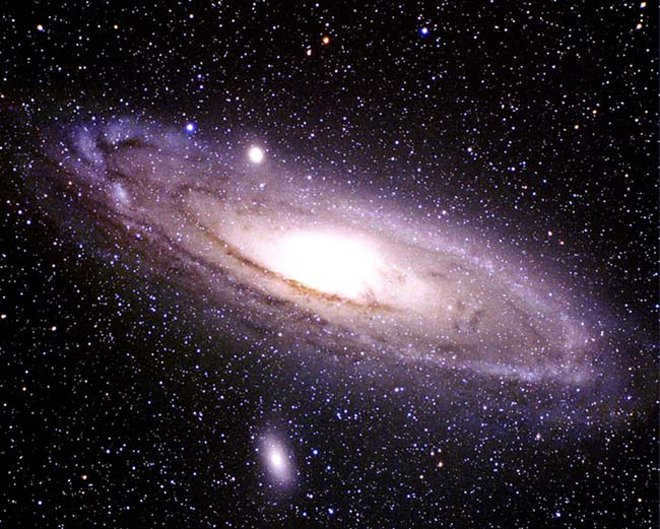
The Galaxy known as the Milky Way is classified as a spiral Galaxy. Researchers have postulated that it consists of four arms. Our solar system, including the Sun, is positioned in close proximity to the Orion arm, nestled between Perseus and Sagittarius. The Sun maintains an orbit approximately 30,000 kilometers away from the Milky Way.
Astronomers have recently conducted studies that propose an intriguing hypothesis – the Milky Way is not solely a spiral galaxy, but rather a spiral galaxy with a junction.
- The Earth is rotated by the Sun every 24 hours. The Sun itself undergoes rotation, but its speed is not uniform across its entire surface. The movements of sunspots indicate that the Sun completes one rotation every 27 days at its equator, but only every 31 days at its poles.
- As previously mentioned, all stars within the Galaxy orbit around the Galactic center, although not at the same rate. Stars located closer to the center have a shorter orbital period compared to those situated farther away. The Sun is located in the outer region of the Galaxy. Based on distance and velocity measurements, the duration of the solar system’s journey around the Milky Way is referred to as a cosmic year. Throughout its 5 billion years of existence, the Sun has completed more than 20 revolutions around the Galaxy.
- During its galactic rotation, the Sun moves up and down in a manner similar to a merry-go-round.
- The Local Group, which includes the Milky Way and Andromeda galaxies, is currently being pulled towards the Virgo cluster, according to the findings put forth by Lopez Luis.






